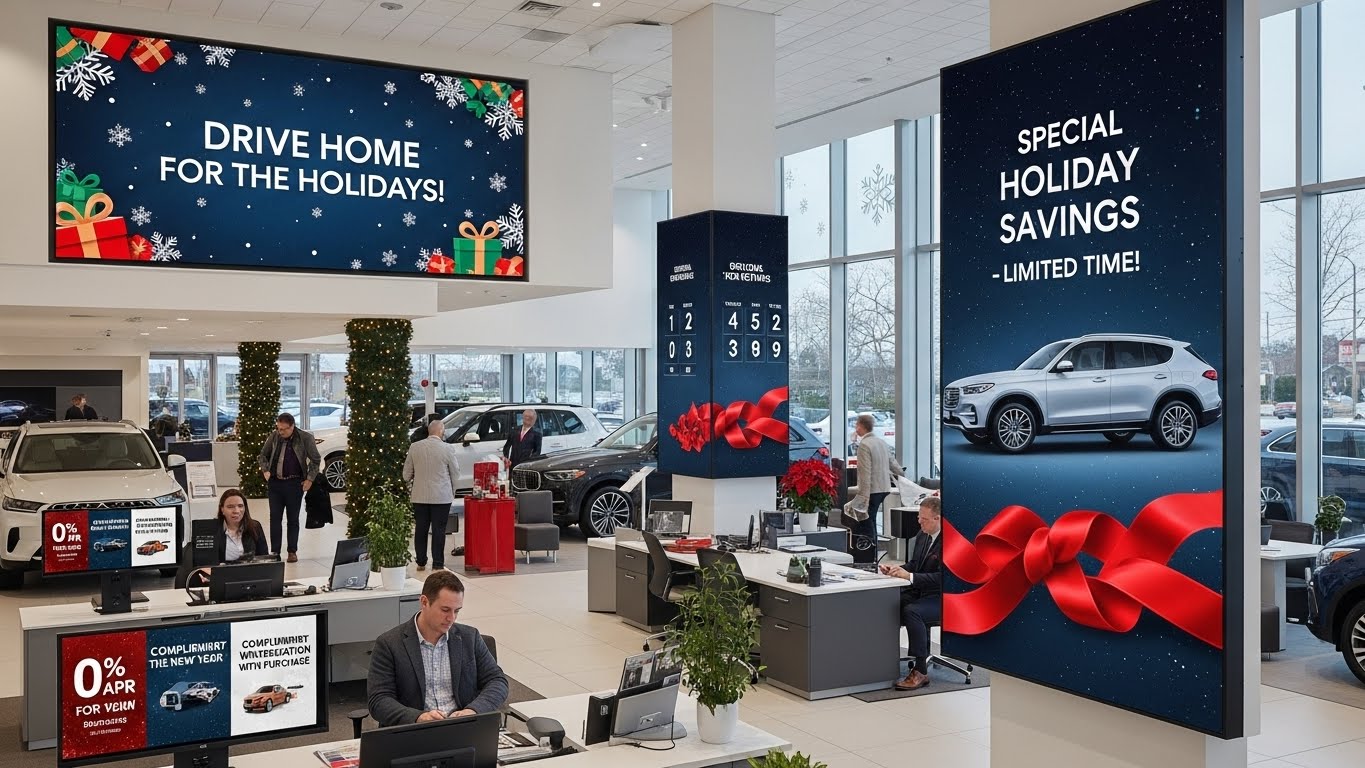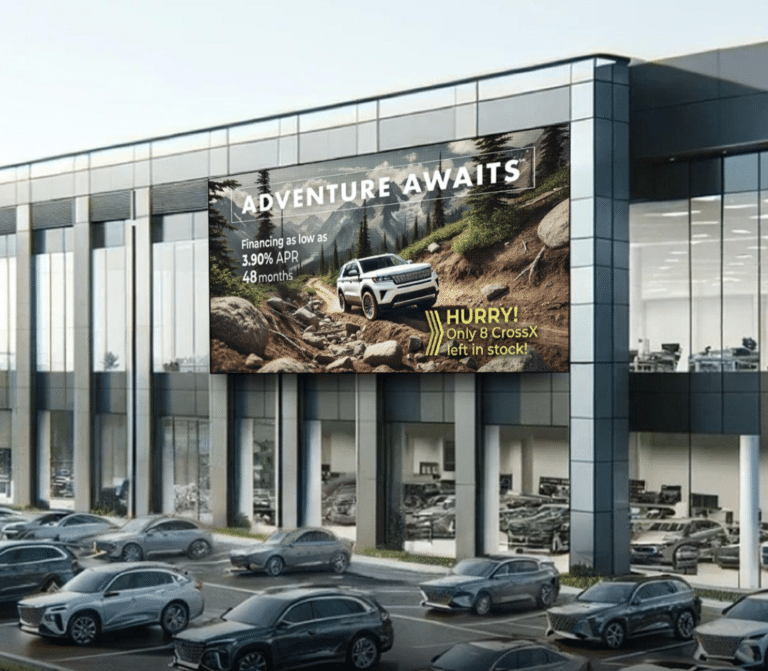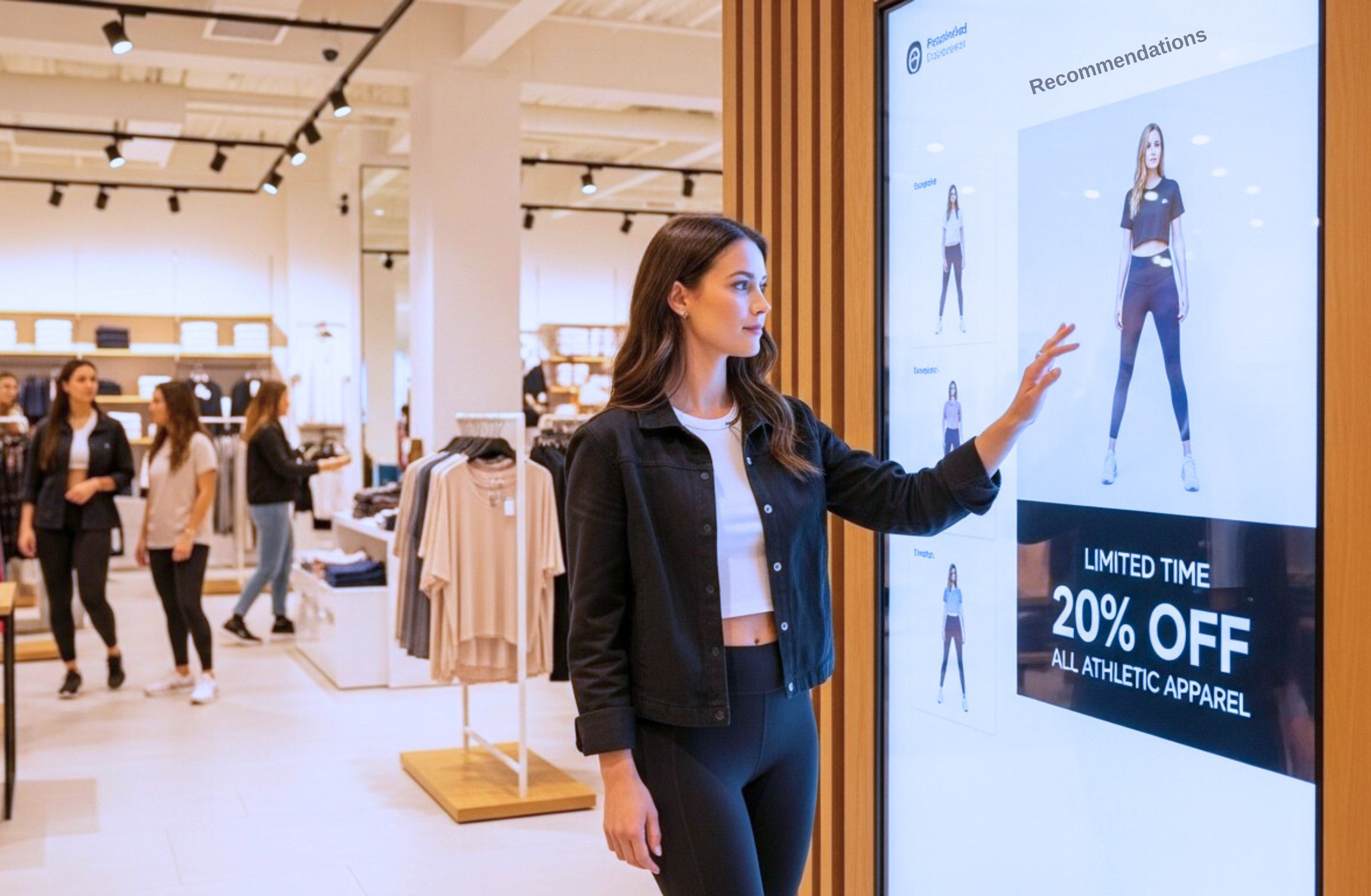
In 2023, the automotive industry improved customer satisfaction through digital solutions and omnichannel shopping. By 2025, more buyers will use a mix of online and in-person tools. Automotive retailers can stay competitive by using digital signage for personalized experiences, transparent pricing, and operational efficiency, enhancing both customer and employee engagement.

2023 was a great year for the Automotive industry. It marked the first year in three when customer experience increased (Cox Automotive, 2023). Overall, approximately 35% of customers expressed that their experience with buying a car this time was better than their previous experience. Some of that boost came from the relinquishment of issues further up the supply chain, but we also saw greater satisfaction with the length of the buying process and key interactions with sales and F&A.
A major contributor to this lift is coming from the growing utilization of digital solutions for the customer and employee experience. Omnichannel shopping has been enabled by a collaboration both on the consumer side and adaptability on the company’s side to reduce in-person steps that used to turn buying, accessorizing or servicing a car into a chore (ahem, financing or poor service experiences…)
Already, 43% of purchases mixed online and in-person steps to complete their transaction – almost neck and neck with the 50% of customers who completed all steps in the dealership. But we can expect omnichannel to become even more important in the next 3-5 years.
71% of buyers expect to use a mix of online and offline tools the next time they shop for a vehicle. And where 7% completed their purchase completely online, that expectation elevates to 21% in their next anticipated purchase. It is critical that a company’s digital solution provides excellent experiences so that the important return revenue for service and future loyalty remains within your brand.
A few takeaways are clear from these numbers. First, companies need to continue their customer experience innovations to compete with online automotive options. And second, they need to focus on integrated omnichannel journeys that capitalize on connected TV and online activity.
They can do this by taking a few distinct steps.
One of the most effective ways a company can capitalize on their physical locations is by implementing advanced digital signage solutions. According to the Trendsetter’s Guide to Automotive Retail (Tripathi and Kahn, 2023), 30% of all dealers are bringing digital retail technology into their stores. Success metrics in aftermarket stores also show the same results: 76% of consumers have reported being enticed to enter stores they had not previously visited due to effective signage, and 68% have made purchasing decisions based on the content displayed on these digital screens (REACH Media Network).
In the broader automotive retail landscape, the use of digital signage has also been instrumental in creating seamless omnichannel experiences, helping to bridge the gap between online and in-store customer journeys. This approach has been shown to enhance the overall customer experience and streamline the purchasing process (Adobe Business).
Digital signage can transform the customer journey in several ways:
As customers enter the lot, digital screens can offer options such as contactless service drop-off, connecting with a sales or service advisor, or starting a self-guided tour. This allows them to self-identify and specify their needs, or even further, can utilize real-time technology to identify their vehicle make and model and integrate with your DMS and website – to seamlessly continue their online journey and greet them personally and proactively for service appointments or their car purchase journey. This initial touchpoint sets the stage for a personalized experience.
Implementing QR codes on vehicle window stickers and on shelf edge displays inside the store or showroom allows customers to access detailed information about each car, accessory or service offering using their smartphones. This approach seamlessly blends physical and digital interactions, capturing the customer’s journey through the lot with actionable insights and data. These insights can be further leveraged by your team to enhance and personalize the customer experience.
In the showroom, parts & service center, repair & upgrade hub – virtually anywhere – customers can interact with digital displays, instantly showing models and features they expressed interest in while on the lot (at the dealership) or online and as they browsed the aisles in an Aftermarket store. This technology not only enhances the customer experience but also provides valuable data to sales representatives.
Digital signage enables companies to provide more transparent and flexible pricing information while complying with consumer protection laws. With 43% of dealerships citing volatile interest rates as a key challenge (Trendsetter’s Guide, 2023), the ability to clearly communicate pricing and offers becomes crucial.
While the Monroney sticker must remain on new vehicles with the MSRP, digital signage can complement this information by displaying:
This approach maintains compliance with the Automobile Information Disclosure Act while leveraging digital technology to provide customers with more comprehensive pricing information, as they are coming to expect in other industries.
Digital displays can show real-time inventory levels and availability across multiple locations, helping customers understand their options and potentially influencing their decision-making process.
By integrating customer data with digital signage, companies can display personalized offers to individual customers that go beyond the base price. For example, if a customer’s lease is nearing its end, relevant lease renewal offers or trade-in values can be shown on nearby screens.
While used cars are not subject to the Monroney sticker law, they are regulated by the FTC’s Used Car Rule, which requires dealers to display a Buyers Guide with specific information. This requirement lends itself even more naturally to the flexibility of real markets.
Buyer’s Guide information is only stage 1 for the modern buyer. As demonstrated by the trend toward omnichannel purchases, consumers are increasingly well informed regarding the used car market in their area.
Conveying this information on the showroom or store floor is a powerful option for retailers to build trust and transparency while at the same time expressing data-driven, compelling reasons to justify the price.
These front end technologies will be even more impactful on the profitability of companies when they are connected with the supply side. McKinsey identified a 2% margin expansion opportunity using dynamic bidding strategies that leverage real-time used car market data. (Data and Analytics in the Driver’s Seat of the Used-Car Market | McKinsey). That is on the supply side alone!
While enhancing the customer experience, digital solutions also help companies reduce costs and optimize their workforce. The Trendsetter’s Guide (2023) reports that 20% of dealerships faced employee burnout as a key challenge. Digital signage can help alleviate this issue:
By enabling customers to explore independently through interactive digital displays, companies can empower the customer and change the dynamic from an initial strain on sales representatives into focused, high-value interactions and complex queries.
Digital signage can help route customers to the most appropriate staff member based on their interests and needs. Staff is informed and empowered by the digital signage with actionable data and insights, improving efficiency and reducing wait times.
Digital displays can also be used for employee training and internal communications, helping to address the 81% of dealers who plan to keep investing in training in 2023 (Trendsetter’s Guide, 2023). More importantly, 70% of dealerships that initiated technology training reported a very high impact on their business overall. Digital displays also support the aftermarket businesses employing digital signage for employee training, who reported using digital signage for training can improve information retention by up to 60%, compared to traditional methods. (IDC)
As we look towards 2025, it’s clear that automotive companies must continue to innovate in order to meet changing customer expectations. By leveraging digital signage to create personalized experiences, implement transparent and flexible pricing strategies, and optimize human resources, companies can differentiate themselves in an increasingly competitive market.
The data shows that companies embracing these technologies are seeing positive impacts. For instance, 48% of trendsetters have enhanced their digital retailing over the past year, compared to just 36% of non-trendsetters (Trendsetter’s Guide, 2023). This digital transformation is not just about keeping up with trends – it’s about creating a more efficient, engaging, and valuable experience for both customers and employees.
As you plan for the future of your automotive retail business, consider how digital signage and other innovative technologies can help you stay ahead of the curve and deliver the exceptional experiences that tomorrow’s car buyers and owners will demand.
At Scala, we have a full-scope solution that helps you lead the industry, and we offer multi-year plans that build digital capabilities while providing return on investment. Check out our Page on Automotive Retail for more information.
Cox Automotive. „2023 Car Buyer Journey Study Summary.“ Cox Automotive, Jan. 2024, www.coxautoinc.com/wp-content/uploads/2024/01/2023-Car-Buyer-Journey-Study-Summary.pdf. Accessed 27 Apr. 2024.
„Data and Analytics in the Driver’s Seat of the Used-Car Market.“ McKinsey & Company, www.mckinsey.com/industries/automotive-and-assembly/our-insights/data-and-analytics-in-the-drivers-seat-of-the-used-car-market. Accessed 27 Apr. 2024.
https://cms.cdkglobal.com/sites/default/files/2023-05/CDK_Global_Trendsetters_2023W.pdf
Tripathi, Rohini, and Peter Kahn. Trendsetters Guide to Automotive Retail. CDK Global, 2023.
“Digital Signage: A Recap of 2023 & Looking Ahead to 2024”
https://reachmedianetwork.com/digital-signage-a-recap-of-2023-looking-ahead-to-2024/ Accessed 8 Aug 2024
Transforming the Automotive Retail Experience with Digital Signage
https://business.adobe.com/resources/webinars/transforming-the-automotive-retail-experience-with-digital-signage.html Accessed 8 Aug 2024
Top Trends in Digital Automotive and Transportation Technology, 2023 Accessed 8 Aug 2024


